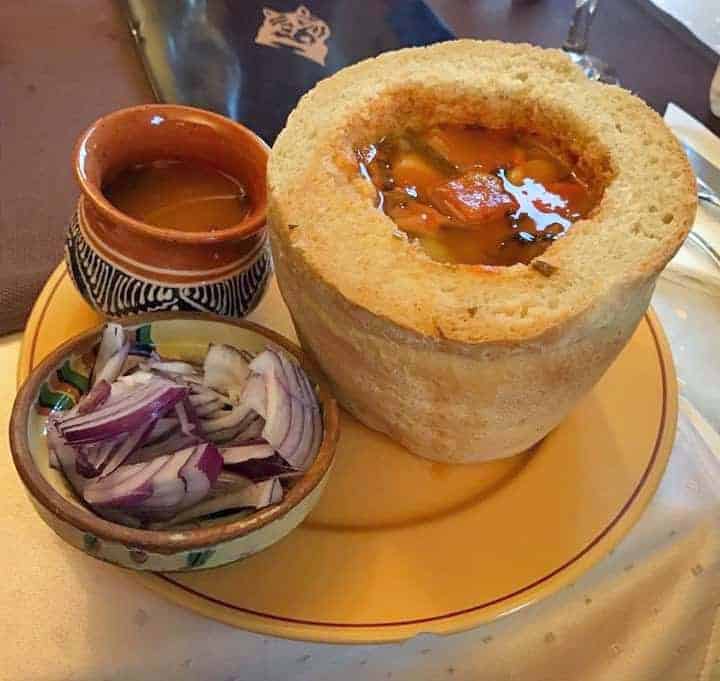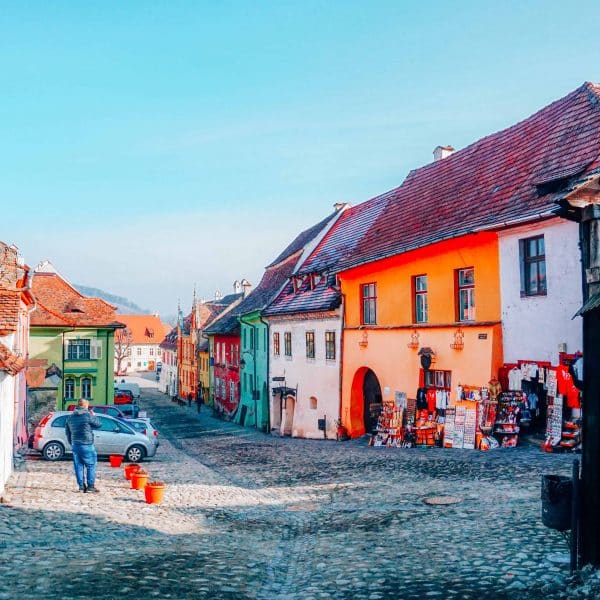When it comes to Romania, it is all about one thing: location. Having been for so many years at the crossroads of several so very different and strong cultures, Romanian cuisine is a unique blend of Turkish, Hungarian and Germanic flavors. But there is some traditional food of Romania you shouldn’t leave without trying.
If you are a meat-eater, you will like it here! Mainly because of the climate, with long cold winters, Romanians have always eaten heavy, meaty dishes but also a lot of soups and broths.
Some great traditional food of Romania you’ll want to try
The best soup/broth (ciorba) in Romania
Romanians have a “soup cult”, you always start your meal with a soup/broth and they also make a clear distinction between the two of them.
I guess for a foreigner it would be kind of hard to decide what to have, with all the options available out there, bearing also in mind that things change from one region to the other. From Ardeal to Moldova, there are different kinds of soups you should know about.
In the Southern and Southeastern parts of the country, ciorba (sour soup) is the thing!
Make it with pork, veal, chicken, vegetable, with meatballs, you name it, you have it!
Moving to the Center and Western part of the country, all soups become sweet. Before you frown, let me add that sweet does not mean sugar is added (even though sometimes this might also be the case), it actually means that nothing is added to make it sour as they do it in the other parts of Romania (borsch, lemon, pickled cabbage juice).
But there is one dish that all Romanians agree with, or better yet, let’s make it 2: beans broth and ciorba de burta.

The first is usually eaten straight from a dish made out of bread (especially in Transylvania, but lately this has been adopted also in other parts of the country), it is thick, hearty and contains smoked pork bone which gives it a distinct flavor to be enjoyed with red onion and salt.
The second one is the Romanian cure for a hangover! After a night out in the club, a ciorba de burta goes a long way! It is done with pork belly and it is served with sour cream and garlic.

Strangest, but still amazing, Romanian dishes you should try
- Piftie: have you ever thought about eating gelatine made out of boiled pig’s ears, head, and feet? Well, you should! This dish is typically made for Christmas and served as an appetizer and it’s actually not as bad as it sounds
- Brain pane – be it veal or pork’s brain, run it through the batter, fry it and it’s served! I know it does not sound appealing but it actually is a very tasty dish
- Caltabosi/sangerete – if you are a sausage fan, you will enjoy these two types of sausage usually made for Christmas. The strange thing about them is the coating in caltabosi’s case which is filled into the large intestine of the pork and the fact that pig’s blood it is used to make sangerete (the mot-a-mot translation would actually mean just that “sausage made from blood”)
- Pork’s tongue with olives – well, the name of the dish says it all. If you would not know from the start what it is that you are eating, it would be a delicious dish.
But don’t panic! There are also plenty “normal” dishes offered by the Romanian cuisine
- Sarmale – minced meat into pickled cabbage leaves, the most typical dish cooked in the whole country for Christmas, Easter and all other special occasions in one’s life (wedding, baptism and so on). You will find different variations of this dish in most of the neighboring countries ( sarma in Serbia, dolma in Turkey, sarma with grape leaves in Greece)
- Mici – minced meat with special seasoning, made on the grill, served with mustard and warm bread. This is another dish found in various forms in the countries around Romania: Ćevapi in Turkey, Ćevap in Serbia, Ćevapčići in Slovenia. It is also the most common thing to be eaten at a barbeque during the hot Summer months.
- Smoked pork knuckle on cabbage – the greatest dish there is, the mother of all dishes. Perfectly cooked at the “Caru cu bere” restaurant in Bucharest, but anywhere else is must try
- Aubergine salad – served as an appetizer, usually with onions; even though it does not look very appealing, it actually is an incredibly good dish. I had someone from Italy once telling me she had a friend who cooked this dish and her son was obsessed with it
- Bulz – something mostly served in the center and western part of Romania, bulz is a mix of polenta, cheese, pancetta, and a fried egg, all baked in the oven until the cheese becomes smooth and gooey
- Zacusca – maybe my favorite thing to eat in Autumn when my mother cooks it and the house smells like this aubergine and pepper goodness.
Amazing Romanian Desserts
- Cozonac – like panettone in Italy, cozonac is the holiday sweet for Romanians. It takes a long time to master the recipe and a lot of physical effort goes into making this. Cozonac is a kind of sweet bread filled with cocoa and nuts, but also with Turkish delight in some cases
Source: Pixabay - Pasca – some sort of cheesecake, but not quite, traditionally made for Easter
- Coliva – ok, this could easily go under “strange dishes”, only because it is served for funerals. It is the simplest and tastiest dessert there is barley boiled with some sugar, nuts, lemon zest, cinnamon and rum flavor. Served cold, with some coconut flakes on top.
- Papanasi – the mother and father of all desserts! Prepare to be blown away by this donut-y extravaganza. The dish is some sort of donut made with cheese and lemon zest, served with a lot of sour cream and fruit jam.
Source: Pixabay
Where to eat the most amazing Romanian food?
- “Caru’ cu Bere” in Bucharest – if you are looking for dinner and a show, this is the place where you will find all that! Located in Bucharest’s city center, it is true that the restaurant is one of the most tourist places there are, but the food is amazing and you will get to eat in a historic monument while enjoying some traditional music and dances.
- “Gaura Dulce” in Brasov – While serving delicious traditional Romanian food, the funniest part about this old restaurant in Brasov is its name. Meaning “the sweet hole”, the restaurant has this name because of its location dating back in time, right in the back of the “Carpathian Deer” restaurant.
- “Mahala” (slum, suburb – making reference to the old city) in Bucharest – with a very special design, this relatively new restaurant open in Bucharest impresses both with its ambiance and its good traditional food.
- “The Old Sibiu” in Sibiu – right in the heart of Romania, this restaurant offers special dishes served in Transilvania, all damped with incredible wine from all parts of the country: from the fruity Tamâioasa Romaneasca to the beautiful light yellow, that glitters in the sunlight Riesling de Rhin
Other travel resources for when you visit Romania
- See whether is Romania safe to visit?
- Take some of these day trips from Bucharest
- Don’t miss out on Romania’s hidden gem: Oradea
- Spend the perfect one day in Bucharest and take some great pictures in these Bucharest Instagrammable places







This is a great guide for all the foodies out there. My best tip – often the lesser known restaurants that have a traditional cuisine have some of the best food.